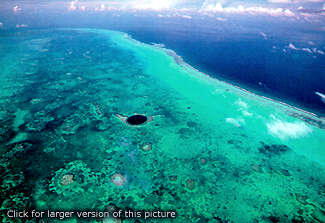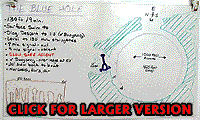 
The Great Blue Hole
|
 Belize Dive Map front |
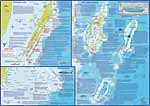 Belize Dive Map back |
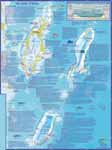 Belize Atolls Dive Map |
 Ambergris Caye Dive Map |
 Placencia Reefs Dive Map |
Almost all the divers who visit Belize are keen to add this splendid dive site to their list of conquests. When they understand what the hole is and how it was formed, it makes the dive all the more exciting. The Blue Hole is a "karst- eroded sinkhole." It was once a cave at the center of an underground tunnel complex whose ceiling collapsed. Some of the tunnels are thought to be linked right through to the mainland, though this has never been conclusively proved. The mainland itself has many water-filled sinkholes that are connected to caves and tunnels.
At some time many millions of years ago, two distinct events occurred. First, there was a major earthquake and this probably caused the cave ceiling to collapse forming the sinkhole. The upheaval, however, had the effect of tilting Lighthouse Reef to an angle of around 12 degrees. All along the walls of this former cavern are overhangs and ledges, housing pleistocene stalactites, stalagmites and columns.
Some of the stalactites now hang at an angle, yet we know they cannot develop at any angle other than perfectly perpendicular. In addition, there are those stalactites which were formed after the earthquake and others which were formed both before and after that cataclysmic event-the top of the stalactite being at an angle and the bottom being perpendicular.
Video: Belize April 2010 & Blue Hole
At that time the sea levels were much lower than today and the second major event was to change all this. At the end of the Great Ice Age the glaciers melted and sea levels throughout the world rose considerably. This process occurred in stages. Evidence for this are the shelves and ledges, carved into the limestone by the sea, which run the complete interior circumference of the Blue Hole at various depths. The first of these ledges is found between 150 and 165 feet (45-50 m) and is best visited on the south side. The base of the ledge is perfectly flat and cuts back into the rock some 15 to 20 feet (5-6 m). This creates an ever-narrowing cavern until the roof reaches the floor right at the back. Here in the V- shaped ledges, cut into solid limestone, are stalactites, stalagmites and columns (where stalactites and stalagmites have joined) which do not exist in the shallower waters of the Blue Hole.
There is very little marine life in the hole, and the walls are of bare rock largeiy due to the scarcity of direct sunlight on the walls, but this hardly matters. Occasionally a lone hammerhead shark is seen, but the general lack of fish, and therefore food, suggests that the creature was simply passing through. The only other fish I have seen were four pompano, but other species have been seen, especially on the south side. Lemon and blacktip sharks, and horse-eyed jacks are spotted with some regularity.
Diving the Blue Hole is not for beginners, although anyone can complete a shallow dive and claim to have dived this marvelous wonder of nature. The deeper one dives into the Blue Hole, the clearer the water and the more breathtaking the scenery. But diving deeper than sport diving depths is for specialists only and cave diving requires even more training and equipment. This type of diving is not generally available in Belize, but a few groups have visited the Blue Hole in order to explore the tunnels and caves which extend from within. On the western side at a depth of 230 feet (70 m), there is an entrance through a narrow tunnel into a large cavern. In total darkness the stalactites, stalagmites and columns exist in an undisturbed world. The floor is covered with a'very fine silt which billows into great clouds with the slightest movement from a passing diver. In the farthest corner, another narrow tunnel leads upwards into a second cavern and then another leads finally to a third cavern. Here are the skeletal remains of turtles which found their way in but never found their way out. This is the very danger which faces a diver. Now at a depth of only 100 feet (30 m) he must find his way back by the same route down to 230 feet (70 m) before he can commence his surfacing and decompression schedule. if he, his buddy or even a turtle have stirred up the silt, the chances are he will never find his way out again. For those qualified cave divers, this is a very rewarding dive.
The Great Blue Hole is not marked on Admiralty Charts-the task of a survey ship is to map that portion of reef which represents a danger to shipping. The hole is found almost exactly in the center of the reef on a course of 3300 from Harrier Wreck. An entire diving trip to Belize is worth the effort and expense for this single dive.
Contrary to rumors, although Cousteau did explore the depths of the Blue Hole with his minisubmersibles in the 60's, he did not lose his son Philippe here, he died elsewhere in a helicopter accident. Neither did Cousteau randomly use explosives to destroy the patch reefs while navigating the "Calypso" in the Blue Hole. He did selectively remove, by limited blasting, a very small area to enable the "Calypso" to reach the Blue Hole.
Several divers have lost their lives in the Blue Hole for various reasons, and as usual, caution is the rule and divers should be fully aware of safety as cave diving rules will apply when they enter the stalagtite-stalagmite area.
Traditionally, before the 1960's, the Blue Hole, because of its awesomeness, was a place very much respected and feared by all who saw it. Lighthouse Reef, an atoll approximately 25 miles long and 10 to 12 miles wide, has a typical enclosed lagoon. The depths in this lagoon vary from 5 to 25 ft., and in it there are many scattered coral formations known as "patch reefs". In the northeastern section of this otherwise shallow lagoon a mariner will come across this indigo blue apparent abyss. Up to the 60's old timers would claim that this hole was bottomless. Because such a blue hole was so striking against a background of tranquil pastel greens of the shallow atoll lagoon, one may be reminded poetically of Homer's accounts in the "Odyssey" of the whirlpool "Charybdis" that gave one a choice of two dangers. IN THE BLUE HOLE THERE ARE NO WHIRLPOOL LIKE CURRENTS, SO DIVERS NEED NOT FEAR THIS.
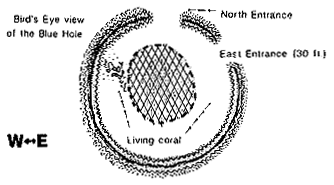
The Blue Hole is the result of the repeated collapses of a cave system formed during lower sea level stands. The reason that the hole is 475 deep instead of the shallower 390 foot depth is that this atoll is on a geological fault block that has been subsiding into the basin through geologic time. |
In the early 60's, Al Giddings, noted underwater cinematographer and
pioneer, first dove in the Blue Hole. Al Giddings chartered a boat called
"The Geek" (a 40 ft. U.S. Navy surplus Captain's "Gig").
"The Geek" was owned by an ex-U.S. Navy frogman, Richard "Dick"
Moore, who started one of the earliest SCUBA diving businesses in Cuba in
1959. Because at the political climate in Cuba, "Dick" moved to
the coast of Yucatan and participated in diving the shipwreck off Matanceros.
This was a Spanish galleon apparently coming from the Old World to the New
World as mentioned in the prior shipwreck section as "Nuestra Senora
de los Milagros" and was carrying trade items to deliver to the New
World. A vessel like this probably would not be carrying large amounts of
gold and silver, but "Dick" expressed that some of the divers
found about 9 lbs of gold leaf.
"Dick", the first real underwater SCUBA diving pioneer in Belize,
subsequently moved to Ambergris Caye and bought some property in the Bacalar
Chico area. Subsequently "Dick" sold his property and moved to
southern Belize off Punta Gorda, to an island called Frenchman's or Peter's
Caye, and continued his diving explorations in southern Belize. When he
died, his request was to be buried on his island, and his request was granted.

One of the early articles in the 60's in "Skin Diver" Magazine,
written by Al Giddings, describes his explorations in the Blue Hole at that
time, wherein he first describes the stalagtites and stalagmite formations.
The first serious underwater documentary on the reefs of Belize was filmed
by Al Giddings. This documentary was called "The Painted Reefs of British
Honduras". The second serious underwater documentation, which included
35mm footage of the Blue Hole was sponsored by the Canadian Film Board,
1965 or 1966 (about).
The senior author (RLW) had the privilege of participating in this expedition as a marine biologist. Several dives were made to the 200 ft level. The sport of SCUBA diving and underwater photography were beginning to come of age.
Jacques Cousteau thoroughly explored the Blue Hole in the late 60's and released one of his television documentaries about blue holes, including those in the Bahamas. He sounded its depths and recovered one of the fallen stalagtites-stalagmites at the bottom of the approximately 475 ft deep hole.
In the late 60's or early 70's, a diving expedition from Caye Caulker claimed that they had witnessed, while SCUBA diving, the very apparition of a genuine SEA SERPENT. This beast reportedly had red eyes, apparently as long as 20 ft.? semi-transparent and eel-like in shape, The dorsal and pectoral fins were apparently extremely long and flowing, and reportedly created some apprehension in the minds of the divers. On the basis of their descriptions, the only fish that would fit this description, would have been the ribbonfish or oarfish (Family Cepolidae), however, the oarfish is an open water, pelagic fish, and its presence in the Blue Hole would have been very unlikely.
Recently, in the last 10 years, many divers have safely visited and dived the Blue Hole. As far as the "monster" is concerned, Out Island Divers, along with other local dive boats, have for several years, been leading weekly expeditions from Ambergris Caye to the Blue Hole and have made hundreds of dives. The only recent "monsters" seen while SCUBA diving were themselves.
Click here for The Legend of the Blue Hole Monster
BEACHCOMBERS TIP:
Once you pass the 60 ft. level, there is not much coral
to see. At depths of 80-90 ft. the Blue Hole may appear somewhat sterile.
One will not see the large sponges or large coral formations, that one will
see at the same depth at the main reef drop off. One may see large jacks
(fish), maybe a large shark or two, or groupers. The Blue Hole is not spectacular
for its biology, but acre for its total mind absorbing awesomeness. At depths
120 to 155 ft. deep, one must realize that 10,000 to 11,000 years ago this
was a land cave. Man was probably still a hunter-gatherer and possibly a
cave dweller (although he probably never lived in this particular cave).
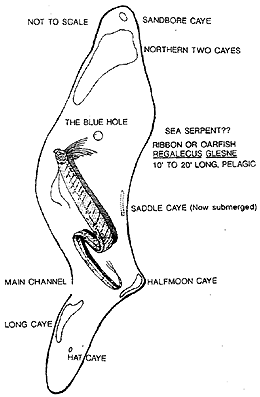
THE BLUE HOLE IS WELL WORTH THE DIVE.
Some of the largest lobsters found in Belize are on the main atoll reef at Lighthouse. The reef at Lighthouse is very wide, well developed and is more massive when compared to the main barrier reef in northern Belize. In the very shallow water pools and caves in the middle of the atoll reef, some of these very red lobsters are 4 ft. long from the tips of their antennae to their tail.
At one time in the early 70's the senior author, RLW, observed what may be termed a "conch walk" at Lighthouse. In the Thalassia-sand flats in between the patch reefs, hundreds of conch in depths of 20 to 25', spaced about 11 apart, were seen at dusk moving in a southwesterly direction. RLW reoriented many towards the north, but upon release, the conch immediately resumed a southwesterly path. These were all adult conch with thick lip development.
For more on the Great Blue Hole, click here.
Incredible new exploration of the Great Blue Hole. The Cambrian Foundation
successfully completed a study of the Blue Hole and its cave systems with high resolution video and the latest diving equipment. An unknown cave system
called the Abyss by local fishermen was explored to a new Belizean underwater cave depth record
of 485 FSW.
Click here for their press release dated Sept. 22, 1997.
Here is information on what it is like diving the Great Blue Hole....
So You're a Diver? Let's Blue Hole It!!
by Wendy de la FuenteHi. Welcome to Belize and Caye Caulker. You have just made a conscious decision to enter the gates of paradise. Some of the most awesome diving in the world is done here. The second longest barrier reef in the world runs along the coast of Belize. Belize has many world class dive sites to captivate you. Today, however, we will go over my favorite trip - the Blue Hole trip.
Several dive shops on the island offer snorkeling or dive trips to the Blue Hole, made famous by world renown diver Jacques Costeau. The Blue Hole is located inside one of Belize's three atolls, the Lighthouse Reef atoll. Inside Lighthouse Reef, there are five islands, two of which are Half Moon Caye and Long Caye. Our trip today will take us alongside these two islands.
Departure time to the Blue Hole is at 7:00 a.m. Wake up with the coffee and rolls on board. Commute time will be 2 hrs. The first 45 minutes of the commute will be over open waters. This can be a bit choppy but is bearable. It is entirely possible to spot dolphins frolicking in the water during the commute. After about 45 minutes, we will enter the Turneffe Atoll. Since this is inside the reef, the calm waters are most welcome after the first stretch. Don't get too comfortable, though, 20 minutes into the smooth sailing you are once again on open seas. This for an additional 40 minutes. Then we enter the lighthouse atoll, home of the Blue Hole. It should be a little past 9:00 a.m. now. Here we are!
Time to get suited up and geared up. The divemaster gives the dive profile - 130 ft. for 8 minutes. At this depth you will be diving among the stalagtites and stalagmites. Scientists believe it takes 100 years for stalagtites and stalagmites to grow just one inch. Some of these are 40 feet in length. Look out for the Black Tip sharks below you. They usually linger in around 160 feet of water. Diving in the Blue Hole is like diving into a black abyss. Enjoy the feeling going down but be sure to face the wall on your way down. It is easy to get disoriented facing the center. After 8 minutes cruising among the stalagmites and stalagtites, we will ascend slowly on an incline until we reach the shallow coral formation up around 20 feet. Here we will do a safety stop of 15 minutes. Ready?? Let's descend..
The second dive will be done at the Half Moon Caye wall. Surface interval between dives will be the commute time from the Blue Hole to Half Moon Caye. Let me just digress here for a second. This commute is probably one of the most breathtaking boat rides one could ever hope to take. The sea is literally a bed of hundreds of shades of blues and greens. Moments are like this many people look up and thank a bigger being for the wonder of nature. This pristine area of the world is uncomparably beautiful.
A national park, Half Moon Caye is the home to the red-footed booby birds. Found only in Belize and on the Galapagos Islands, they are pretty special birds. We will visit the booby birds when we lunch on Half Moon Caye. But for now, the second dive awaits us. Dive profile for the second dive is 60 feet for 40 minutes.
Consensus on the second dive - AWESOME!!! The Half Moon Caye Wall is literally covered with what I prefer to call soft corals. There are huge barrel sponges, fans, tube sponges and gorgonians to make you feel like you are on a movie set. Since the wall drops to 3,000 feet deep, the ground in the shallow area the blue hue makes this dive utterly unreal! The garden eels buried on the ground in the shallow area sway back and forth to camoflague themselves from intruders. At the advancement of any intruder, they duck into the sandy bottom below. The lonesome turtles seen floating among the corals makes the second dive even more spectacular.
Hungry now? No problem. At Half Moon Caye lunch is a delactable buffet prepared just for this trip. There are lots of drinks and water to quench any diver's thirst. Enjoy, relax, swim in the hammock, walk around the island if you wish. If you do, be sure to climb the observation deck to view the birds in their natural habitat.
Third dive stop - an area near Long Caye referred to as the aquarium. The aquarium is aptly named due to the endless schools of fish life that cover this area. The coral formations on the bottom form many tunnels and crevices where a diver can easily loose him/herself in the wonder of it all. Aside from the breathtaking underwater view of the schools of colorful fish, the real delight at this dive site is definitely the two dolphins that sometimes come over and frolick in the water with the divers. There are only a few places in the world where you can swim with the dolphins in the wild. This is but one of the special places where the dolphins are still in the wild, but friendly.
Dive profile for this dive is 50 feet for 40 minutes. Again, we cruise along the outside here at Long Caye. The bottom of the wall here is again a mindboggling 3000 feet. The divemaster again reminds us not to touch the bottom.
Tired but happy, we head back home. After an absolutely amazing day we return to the island. Tired... but happy and fulfilled!!
(If you have any questions about the Blue Hole dive or any other dive, please e-mail [email protected]. This article is provided courtesy of Caye Caulker Travel and Tours.)
Experience a Dive in the World Famous Belize Blue Hole
Thousands of scuba divers visit Belize yearly, and many of them only have the Belize Blue Hole in mind. This might be because itís the most popular dive site in the country, and is one of the most advertised by local tourism investors. However, the Blue Hole is now just known as a bucket list dive, something that you wonít care to visit again. But thereís hope for this, as false expectations and assumptions are the main causes of disappointment. This dive site is different, though; itís the kind of novelty that, with the right conditions, can be enjoyed when approached with the right expectations and mindset.
The dive starts with a descent to a sandy limestone shelf surrounding the Blue Hole
The shelf starts as a wall covered with coral, and then becomes a gentle sandy incline that leads up to a dark abyss. If you dive from local dive boats, youíll be given about a minute or two to descent and equalize if youíre led to the drop off where will freely go down into the darkness. As you go down, the depths drain the colors to a gloomy shade pretty much the same from the natural light seen after dusk. Further down, youíll see silhouettes of one of the most fascinating predators of the ocean.
You continue past gigantic stalactites hanging from the ceiling like chandeliers from the Stone Age
This is a reminder of the jungle caving expedition of Actun Tunichil Muknal, which you might have visited early on your trip. These cave formations have existed for many millennia even before the famous voyage of Christopher Columbus. In the distance, youíll see the silhouettes of sharks circling their territory, bolting toward the shallower depths above. On uncommon occasions, keep an eye open for a hammer head sightings. They live in the area and might appear out of the darkness.
Then you will start your slow ascent from the maximum depth
Youíll come up past the sharks again, with an occasional curious one coming within an armís reach inspecting the visitors in its territory. Youíll arrive on the sandy shelf, and be treated to small bubbles dancing out of tiny holes in the sandy floor. Then the shape of your dive boat will appear above, with your dive leader signaling you to do a safety stop. In total, youíll finish the dive in 30 minutes, which is something you should prepare for if youíre a diver who loves 60-minute dives.
With a dash of luck, this Belize Blue Hole cruise can be a worthwhile experience. However, itís important that youíre aware of the dangers of this kind of dive, including the personal duties you have as the diver, even when youíre under the supervision of a dive master. If you have a dive computer, adjust the depth according to your No Decompression Limit. If youíre using a rental computer, ensure that youíre briefed on how to use it and always ascend at a reasonable rate. Make sure that you take the necessary steps to remove as much potential stressors for a better dive down the Belize Blue Hole depth.
Ascend until you get the signal from the dive master and ascend if they tell you
Itís also helpful to have a dive buddy who will not be a stress to you and to the other divers.There are many divers who came up unmoved with what Belize blue hole diving has to offer. But perhaps if your expectations werenít too high, and the conditions were excellent, the dive just might be something unforgettable. If you find yourself vacationing in beautiful Belize, looking for an underwater adventure, contact dive tour companies in Belize for their Belize Blue Hole tours packages and rates.
For an Australian newspaper article on diving the Great Blue Hole, CLICK HERE.
For a great story on diving to the bottom of the Great Blue Hole, CLICK HERE.
For a National Geographic Travel Photo Gallery on the Blue Hole, CLICK HERE.

|
|
Related Links:
Great Blue Hole videos
Great Blue Hole photos and stories
Skydiving into the Great Blue Hole
For more information, follow these links:
Blue Hole Origin and Sea Level Change
Diving in Belize and Ambergris Caye
Ambergris Caye Barrier Reef
Map and info on Ambergris Caye Dive Sites
Commons
Island
Community
History
Visitor Center
Goods & Services
Search
Messages


Copyright byCasado Internet Group, Belize
